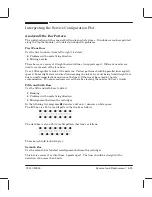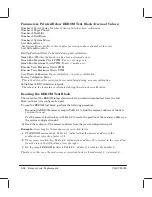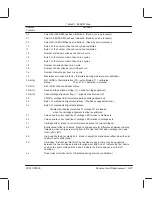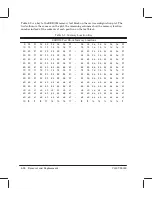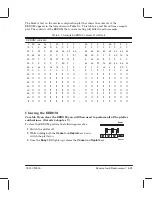
8Ć14 Troubleshooting
C3187Ć90000
BailĆLiftĆMechanism Failure
Normal BailĆLift Sequence
The following is what should happen during a normal bailĆlift sequence:
,
The cartridge carriage positions over the engagement lever. This connects the autoĆlift
mechanism to the driveĆroller gear. The media motor becomes the driving force for the
autoĆlift.
.
The media motor drives the drive roller, which in turn drives the bail autoĆlift. The bail
begins raising up until the UP" position is reached.
A
The carriage moves away from the engagement lever so that the media may be driven by
the drive roller without affecting the position of the bail. (The bail is kept in the up
position by the left bail arm resting in the notch on the gear cam.)
4
After the media is moved forward, the carriage again positions over the engagement lever.
The media motor then drives the bail autoĆlift and the bail lowers to the down position.
When the bail is down, it presses on the bail sensor switch. This is how the plotter knows the
position of the bail.
Problems
D
The cam gear and engaging gear detach from the driveĆroller gear even though the
carriage is still actuating the engaging lever. This can happen due to excessive part
tolerances or wear.
D
The engaging lever spring is installed on the lower rung of the YĆdrive bracket, creating
too much spring tension. Excessive spring tension accentuates any looseness in the bail
lift parts. Install the spring on the upper rung.
D
The carriage does not properly locate the engagement lever, preventing the gears from
engaging. Any problems with the carriageĆmotor control system (for example, the
encoder strip) or associated mechanics could cause this problem. Also, if the carriage
cannot find the true left stop during initialization (caused by interference), the engaging
lever cannot be located. Possible causes of interference are the serviceĆstation sled and
the main tensioner bracket.
D
The bail falls from the up position. This can result if the cam is over or underĆrotated.
The notch on the cam, used to catch the left bail bracket, is not properly located for the
bail up" condition, and the bail falls abruptly. A bail calibration may correct this
problem.
Teflon Washers versus CamĆGear Support
Problems can arise if the lift mechanism is too loose or too tight. The solution in the
DesignJet 200 involved the use of teflon washers. A new solution comes with the
introduction of the DesignJet 220 and involves a new part called the camĆgear support.
(Details
D
chapter 9,
w
.)
Summary of Contents for CalcPad 200
Page 1: ... ...
Page 3: ... ...
Page 14: ... ...
Page 15: ... ...
Page 19: ... ...
Page 22: ...2Ć4 Site Planning and Requirements C3187Ć90000 ...
Page 23: ... ...
Page 27: ... 4 1 2 3 4 5 6 mm 0 25 in 5 1 2 3 4 5 B A B A A B A B X X X ...
Page 31: ... ...
Page 33: ... ...
Page 65: ... ...
Page 139: ... ...
Page 149: ...8Ć0 8 Troubleshooting ...
Page 178: ...8Ć30 Removal and Replacement C3187Ć90000 ...
Page 179: ...9Ć0 9 Product History and Service Notes ...
Page 193: ...10Ć1 10 Parts and Diagrams ...
Page 197: ...10Ć5 Parts and Diagrams C3187Ć90000 Legs and Media Bin 1 2 3 3 4 5 6 7 1 3 4 3 3 3 3 3 8 8 ...
Page 199: ...10Ć7 Parts and Diagrams C3187Ć90000 Window Center and Bottom Covers To Carriage ...
Page 203: ...10Ć11 Parts and Diagrams C3187Ć90000 Left Endcover and Trim ...
Page 205: ...10Ć13 Parts and Diagrams C3187Ć90000 Right Endcover and Trim ...
Page 207: ...10Ć15 Parts and Diagrams C3187Ć90000 Carriage Axis Drive Left End ...
Page 209: ...10Ć17 Parts and Diagrams C3187Ć90000 Service Station 1 2 3 3 4 5 7 6 6 ...
Page 215: ...10Ć23 Parts and Diagrams C3187Ć90000 Media Drive Assemblies ...
Page 219: ...10Ć25 Parts and Diagrams C3187Ć90000 Bail and Overdrive Assemblies ...
Page 221: ...10Ć27 Parts and Diagrams C3187Ć90000 Pinch Arm Assembly ...
Page 227: ... ...
Page 231: ... ...
Page 244: ...IndexĆ04 C3087Ć90000 ...
Page 245: ... ...


























